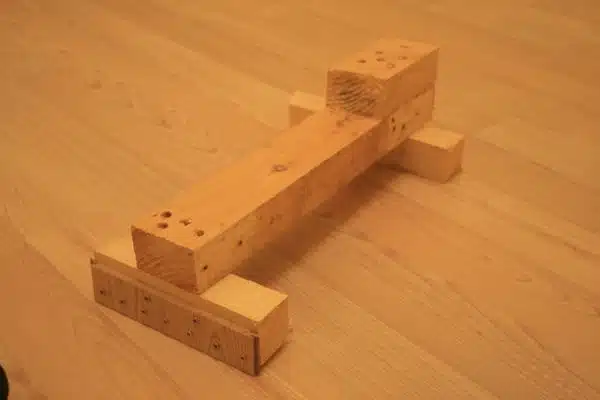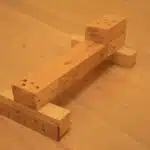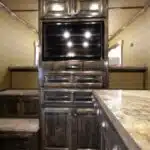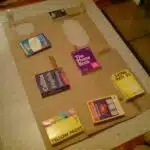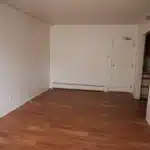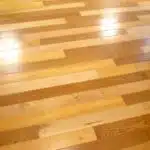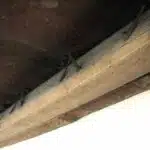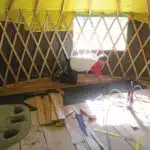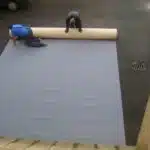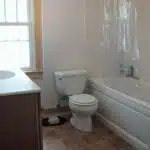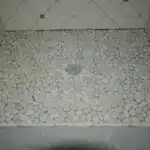Laminate flooring has become a popular choice for homeowners due to its affordability and ease of installation. However, there may come a time when you need to remove the laminate flooring for various reasons such as damage or renovation. Removing laminate flooring can be a daunting task, especially if you don’t have the right tools and knowledge.
As an expert in flooring installation and removal, I understand the importance of knowing how to properly remove laminate flooring without causing damage to your subfloor or surrounding areas. In this article, I will provide you with step-by-step instructions on how to remove laminate flooring safely and efficiently. Whether you are a DIY enthusiast or a professional contractor, these tips will help you tackle this project with confidence and ease while serving others who may need your expertise in the future.
Preparing For Laminate Flooring Removal
Proper preparation is key to successful laminate flooring removal. Before starting the process, it is important to ensure that you have all the necessary tools required for the job. This includes a pry bar, hammer, utility knife, pliers, gloves, safety glasses and a dust mask.
It is also essential to take the necessary safety measures when removing laminate flooring. As you remove the planks or tiles, they are likely to break apart into small pieces which can easily cause injury. To avoid this risk, it is recommended that you wear sturdy work boots and knee pads to protect your legs from any flying debris.
Additionally, it is important that you turn off any electrical power sources in the room before beginning your project. This will reduce the risk of electrocution if any wires become exposed during the removal process. By taking these safety precautions and gathering all the necessary tools beforehand, you can ensure a safe and efficient removal process without any unnecessary setbacks or accidents.
Gathering The Necessary Tools And Equipment
After preparing the area for laminate flooring removal, it is necessary to gather all the tools and equipment needed for this task. Having the right tools will make the process much easier and faster. Some of the essential tools you will need include a pry bar, hammer, chisel, pliers, utility knife, safety glasses or goggles, gloves, and knee pads.
Before starting the actual removal process, it is important to take some safety precautions. Ensure that there are no nails or screws protruding from the subfloor that could cause injury. Wear protective gear such as safety glasses or goggles to protect your eyes from flying debris. Gloves and knee pads will also come in handy in protecting your hands and knees respectively.
In summary, removing laminate flooring is not a complicated task if you have the necessary tools and equipment as well as taking appropriate safety measures. Always ensure that you have everything you need before starting to avoid disruptions during the process. In our next section, we will discuss how to remove baseboards and moldings which are crucial steps in preparing for laminate flooring installation or replacement.
Removing Baseboards And Moldings
As a flooring installation and removal expert, you understand that removing baseboards and moldings is a crucial step in the process of removing laminate flooring. This step is necessary since the baseboards and moldings are attached to the wall, which may interfere with the removal of the laminate flooring. To ensure an efficient job, you must have the right tools to remove these fixtures.
Among the essential tools you need for removing baseboards are a hammer, pry bar, utility knife, pliers, and gloves. The pry bar is used to separate the baseboard from the wall while using a hammer or pliers to remove any nails or screws holding it in place. If there are any stubborn nails that refuse to come out easily, use pliers to pull them out slowly while taking care not to damage your walls.
After successfully removing your baseboards and moldings, there’s typically some wall damage that needs repairing. You can choose whether you want to repair or replace your baseboards depending on their condition. To repair damage on walls caused by pulling off baseboards or other molding types, start by filling in any holes left behind by screws or nails using spackle paste. Once dry, sand down any rough spots before painting over them with matching paint colors. This ensures your walls look immaculate without any signs of having had work done on them.
Transition: Now that you have successfully removed your baseboards and repaired any damages caused by this process let’s move on to disconnecting appliances and electronics.
Disconnecting Appliances And Electronics
Did you know that electrical appliances account for approximately 30% of residential energy consumption in the United States? That means, when it comes to disconnecting electronics before removing laminate flooring, it is crucial to do so correctly. Start by unplugging all electronic devices and appliances from the wall sockets to avoid potential hazards. Remember to handle these items with care and place them in a safe area away from the removal site.
Another important aspect of laminate flooring removal is protecting your furniture. Before beginning, move all furniture out of the room or cover them with protective material. This will prevent any damage caused by dust or debris during the removal process. Moreover, if there are any heavy pieces of furniture that cannot be removed, consider lifting them onto boards or sliders to protect them further.
It is essential to prioritize safety when removing laminate flooring, especially when it comes to disconnecting electronics and protecting your furniture. By following these steps carefully, you can be sure that your property remains undamaged throughout the process. Once this has been done, you can move forward confidently with clearing the area for laminate flooring removal without any obstacles or hindrances.
Clearing The Area For Laminate Flooring Removal
To effectively remove laminate flooring, you must first measure the space to ensure that you have an accurate idea of how much work is ahead of you. This will help you determine how much time and effort will be required for the job. In addition, measuring the space will allow you to purchase the necessary tools and supplies needed for the removal process.
Once you have measured the space, it’s time to prepare the area by covering any furniture or other items that may be damaged during the removal process. Use plastic sheeting or drop cloths to cover all furniture and make sure that they are secured in place with tape or clamps. This will prevent any dust or debris from damaging your belongings and keep them clean throughout the project.
With your space measured and furniture covered, it’s time to begin removing your laminate flooring. The process can vary depending on how your particular flooring was installed, but generally involves loosening a few planks at a time using a pry bar or other tool. It’s important to work slowly and carefully so as not to damage any subflooring underneath. Once you’ve removed all of the planks, be sure to sweep up any debris or dust left behind before moving on to the next step.
Starting The Laminate Flooring Removal Process
Imagine you are a seasoned traveler, preparing to embark on an adventurous journey. You must take adequate time to pack and plan before setting off. Similarly, removing laminate flooring requires preparation and planning. Before starting the process of removing the first row of laminate flooring, it is crucial to ensure that all necessary tools and equipment are at hand.
Preparation tips include identifying the type of laminate flooring installed in your space. This information will give you an idea of how difficult the removal process will be and what kind of tools you will need. You should also remove any furniture or obstructions from the area where you will be working to prevent accidents during the removal process.
Safety precautions are important when working with tools such as hammers, crowbars, and knives. Wear safety gloves and goggles to protect your hands and eyes from sharp debris that may fly off during the removal process. If possible, turn off any electrical outlets in the room or space where you’ll be removing laminate flooring to avoid electrocution hazards.
Transitioning into removing the first row of laminate flooring, it is essential to note that this step sets the foundation for a successful removal process. To begin this step, use a crowbar or hammer and chisel to lift up one corner of the first plank carefully. Once lifted, gently pull it towards yourself until it comes apart from its locking mechanism. Repeat this step for each plank in the first row until all planks have been removed successfully.
Removing The First Row Of Laminate Flooring
After successfully starting the laminate flooring removal process, it’s time to move on to removing the first row of laminate flooring. This can be a bit tricky and requires some patience and precision. To begin, you’ll need to use a laminate removal tool to separate the first row from the wall. This will help you avoid damaging the wall while also making it easier to remove the planks.
Next, you’ll want to undercut the first row of laminate flooring. This means cutting off the bottom part of the plank so that it can easily be lifted up and removed. To do this, use your saw or jigsaw to carefully cut along the bottom edge of each plank in the first row. Be sure to wear safety goggles and gloves during this process.
Once you’ve undercut and separated the first row of laminate flooring, it’s time to start removing the remaining planks. This can be done by lifting up each plank individually with your hands or with a pry bar if needed. Make sure to remove any adhesive or nails left behind before moving on to the next section of flooring. With these steps completed, you’re well on your way to successfully removing all of your old laminate flooring!
Moving forward with removing the remaining laminate flooring, there are several key steps that must be taken in order to ensure a successful removal process. These include properly preparing your work area, using appropriate tools for lifting and removing planks, and taking care not to damage any surrounding walls or fixtures during removal. By following these guidelines and taking things one step at a time, you’ll soon have all of your old laminate flooring removed and ready for new installation!
Removing The Remaining Laminate Flooring
As we progress with the removal of laminate flooring, we may encounter instances where some portions are stubborn to come off. It’s like trying to break through a tough shell, but with the right tools and techniques, it is possible to accomplish the task at hand. The following section will provide an in-depth guide on how to remove the remaining laminate flooring without causing any damage.
Using power tools is one of the most effective ways of removing laminate flooring that has become difficult to detach. An oscillating multi-tool equipped with a blade or scraper attachment can help loosen any stubborn areas. A circular saw equipped with a fine-toothed blade can also be useful for cutting through thick portions of laminate.
Dealing with stubborn glue residue is another challenge we face when removing laminate flooring. To remove this, use adhesive removers such as Goo Gone, WD-40 or rubbing alcohol applied directly to the affected area and let it sit for several minutes. Afterward, use a scraper tool to scrape off the glue residue gently. Repeat this process until all glue residue is removed.
Moving forward from removing laminate flooring, there’s still work to be done in ensuring that your subflooring is ready for installation of new materials. The next section will focus on removing adhesive and residue left behind after removing the old material.
Removing Adhesive And Residue
Removing Adhesive and Residue:
Removing laminate flooring can be a daunting task, especially when it comes to removing the adhesive and residue that is left behind. It is important to take the necessary precautions to minimize any damage during this process while also ensuring proper disposal of the materials.
To begin, start by using a scraper or putty knife to remove as much of the adhesive as possible. Be careful not to apply too much pressure as this could cause damage to the subfloor beneath. Once you have removed as much of the adhesive as possible, you can then use an adhesive remover solution to soften any remaining residue.
When applying an adhesive remover solution, be sure to follow the manufacturer’s instructions carefully. Apply the solution generously and allow it to sit for several minutes before attempting to scrape away any remaining residue. Once you have removed all of the adhesive and residue, dispose of these materials properly according to your local regulations.
Inspecting and preparing the subfloor:
Now that you have successfully removed all of the laminate flooring and its associated adhesives and residues, it is time to inspect and prepare your subfloor for new flooring installation. Start by thoroughly cleaning and drying your subfloor surface. Check for any signs of damage or unevenness that may need repair before proceeding with installation. Taking these extra steps will ensure a smooth and successful flooring installation process in your home or business space.
Inspecting And Preparing The Subfloor
After successfully removing the adhesive and residue from the subfloor, it is now time to inspect and prepare it for laminate flooring installation. According to a recent study, about 80% of flooring failures are due to inadequate subfloor preparation. This statistic highlights the importance of proper subfloor preparation techniques before installing new laminate flooring.
Before starting any subfloor preparation, it is essential to have the right tools on hand. Inspecting tools such as a moisture meter, a straight edge, and a level will help determine if the subfloor is level and free from any defects that could affect the new laminate flooring’s stability. Additionally, inspecting for any protruding nails or screws will prevent damage to the new flooring during installation.
Once all necessary inspections have been made, it is time to prepare the subfloor properly. Subfloor preparation techniques include sanding down or filling in uneven areas with floor leveling compound to ensure a flat surface for installation. If there are any significant damages like cracks or holes in the subfloor, they must be repaired before laying down the new laminate flooring.
Inspecting tools and preparing the subfloor are crucial steps in ensuring that your new laminate flooring lasts for years to come. In addition to providing a stable base for your new floors, proper subfloor preparation can also help prevent squeaks and gaps from occurring later on. The next step is repairing any damage found during inspection so that you can move forward with confidence in your newly prepared space.
Repairing Any Damage To The Subfloor
Assessing Damage: It is important to assess the level of damage to the subfloor before repairing any damage. Visual inspection can help to determine any warping, water damage, or other issues that need to be addressed.
Replacing Damaged Boards: When replacing damaged boards, it is important to ensure they are the same thickness and type of wood as the existing flooring. Additionally, the boards should be secured with nails or screws.
Removing Laminate Flooring: When removing laminate flooring, a pry bar can be used to remove the planks. Additionally, a circular saw can be used to cut the planks into small sections for easier removal.
Preparing Subfloor: Once the laminate flooring is removed, the subfloor should be thoroughly cleaned and inspected to determine if it needs to be repaired or replaced.
Assessing Damage
Assessing damage is an essential step in repairing any damage to the subfloor. Before proceeding with any repair, it is crucial to assess the extent of the damage and determine the appropriate repairing options. When removing laminate flooring, it is common for the subfloor to incur scratches or holes that require fixing.
One option for repairing minor damages is using a wood filler or putty. This method involves filling in any cracks, scratches, or gaps with a wood filler or putty that matches the color of the subfloor. Once applied, it is important to let it dry completely before sanding and refinishing the area. However, this method may not be effective for larger damages.
For more extensive damage, replacing the damaged section of flooring might be necessary. This process involves cutting out and removing the damaged section before replacing it with new flooring material such as plywood. When replacing a section of the subfloor, it is crucial to ensure that all moisture issues are addressed before installing new flooring material as water can cause further damage.
In conclusion, assessing damage when repairing any damage to the subfloor should be prioritized to ensure that proper repair methods are used. Flooring replacement and using a wood filler or putty are just some of the available options for repairing damages on a subfloor. By taking time to assess damages carefully and choosing appropriate repair methods, homeowners can restore their subfloors efficiently and effectively while avoiding future problems.
Replacing Damaged Boards
When repairing any damage to the subfloor, one of the options available is to replace damaged boards. This method is necessary when the damage is extensive and cannot be repaired using wood filler or putty. Replacing a section of the subfloor involves removing and cutting out the damaged boards before installing new ones.
To replace damaged boards, you’ll need tools for removal such as a circular saw, chisel, hammer, and pry bar. The first step is to remove the baseboards in the affected area and cut out the damaged board using a circular saw. Then use a chisel and hammer to remove any remaining pieces of the damaged board. Once all pieces are removed, install new boards in their place by nailing them down securely.
It’s important to note that when replacing damaged boards, it’s crucial to ensure that all moisture issues have been addressed before installing new flooring material. If not addressed, water can cause further damage leading to more costly repairs in the future. With proper repair methods and attention to detail during installation, homeowners can restore their subfloors efficiently and effectively while avoiding future problems.
Installing A New Floor
When it comes to installing a new floor, choosing the right flooring is essential. There are plenty of options available in the market, from hardwood to carpeting, and each has its unique benefits. Consider your lifestyle, budget, and preferences before making any decisions. If you have pets or kids who are prone to accidents, a durable and easy-to-clean flooring option like vinyl might be the best choice for you.
While many homeowners prefer DIY projects when it comes to home improvements, hiring a professional installer can save you time and effort in the long run. A flooring installation expert can help you avoid costly mistakes that can damage your new floors or affect their longevity. They have the tools and experience needed to complete the job efficiently and effectively, minimizing disruptions in your daily routine.
Having laminate flooring removed from your home can be a messy process. Once the old flooring has been taken up, it’s important to clean up any debris left behind to ensure that your new floors are installed on a smooth surface. In our next section, we’ll provide some tips on how to clean up after laminate flooring removal so that you can get started on installing your new floors as soon as possible.
Cleaning The Area After Laminate Flooring Removal
Once the laminate flooring has been removed, it’s important to clean the area thoroughly. This will help prevent any potential damage that could be caused by debris left on the floor. Here are some tips on how to clean up after laminate flooring removal:
Sweep or vacuum the area: The first step is to sweep or vacuum the area to remove any loose debris and dust left behind from removing the laminate flooring. Be sure to use a broom or vacuum cleaner with soft bristles or attachments to avoid scratching or damaging the subfloor.
Wipe down with a damp cloth: Once you’ve removed all of the loose debris, wipe down the area with a damp cloth to remove any remaining dust and dirt. Avoid using too much water as this can cause damage to the subfloor.
Inspect for any damage: Finally, inspect the subfloor for any signs of damage like scratches, dents, or cracks. If you find any damage, repair it before installing new flooring.
Disposing of debris and preventing damage are two important aspects of cleaning up after laminate flooring removal. By following these tips, you can ensure that your subfloor is clean and free from potential hazards that could cause further damage during installation of new flooring.
Now that you’ve cleaned up after removing your old laminate flooring, it’s time to dispose of it properly. In the next section, we’ll cover how to dispose of old laminate flooring in an environmentally friendly way without causing harm to our planet’s ecosystem.
Disposing Of The Old Laminate Flooring
Once the old laminate flooring has been removed, it is important to dispose of it properly. There are two main options for getting rid of old flooring: recycling and landfill disposal. Recycling is the more environmentally friendly option, as it reduces waste and conserves natural resources.
Recycling options for laminate flooring include taking it to a recycling center or contacting a waste management company that specializes in recycling construction materials. Some companies may also offer pick-up services for larger amounts of flooring. It is important to check with your local recycling center or waste management company to find out what types of materials they accept and any specific guidelines for preparation and delivery.
If recycling is not an option, the old laminate flooring can be disposed of in a landfill. However, this should be a last resort as it contributes to environmental pollution and takes up valuable space in landfills. To dispose of laminate flooring in a landfill, it must be properly packaged and labeled according to local regulations. It is important to contact your local waste management authority or landfill facility to find out their specific guidelines for disposal.
Moving forward with proper disposal methods ensures that old laminate flooring is handled responsibly and does not cause harm to the environment. In the next section, we will discuss tips for successful laminate flooring removal to ensure the process goes smoothly and efficiently without causing unnecessary damage or frustration.
Tips For Successful Laminate Flooring Removal
When removing laminate flooring, there are several tips that can help ensure a successful removal process. One common mistake many people make is not properly preparing the area before beginning the removal process. It’s important to clear the room of all furniture and debris, ensuring that the area is clean and free of obstacles.
Another common mistake is not taking proper safety precautions. When removing laminate flooring, there may be sharp edges or nails that can cause injury if not handled carefully. It’s important to wear gloves and protective eyewear to prevent any accidents or injuries.
Additionally, it’s important to use the right tools for the job. Using improper tools can damage the subfloor or even cause injury. A pry bar and hammer are commonly used for removing laminate flooring, while a utility knife can be used to cut away any excess material. By following these tips and avoiding common mistakes, you can successfully remove your laminate flooring without causing damage or injury.
By taking the time to properly prepare the area, taking necessary safety precautions, and using appropriate tools, you can ensure a successful removal process when removing laminate flooring from your home. Remember to take extra care when handling sharp objects or working in tight spaces, and always wear protective gear to prevent injury. With these tips in mind, you’ll be well on your way to a successful laminate flooring removal project.
Conclusion
Laminate flooring removal can be a daunting task, but with the right tools and preparation, it doesn’t have to be. Before starting the process, it’s important to disconnect appliances and electronics and clear the area. Removing baseboards and moldings is also necessary before beginning the actual removal of the laminate flooring.
Once the old flooring has been removed, it’s time to install a new floor of your choice. Cleaning the area thoroughly after removal is important to ensure a smooth installation process. Finally, disposing of the old laminate flooring in an environmentally-friendly way will help keep our planet clean.
As an expert in flooring installation and removal, I highly recommend following these steps for successful laminate flooring removal. With proper preparation and care, you can achieve a beautiful new floor that will last for years to come. Don’t hesitate to seek out professional assistance if needed, as they can provide valuable expertise and guidance throughout the entire process. Remember: a little bit of effort goes a long way towards achieving your desired result!
Image Credits
- “Laminate flooring tool” by Greg Pye (featured)

